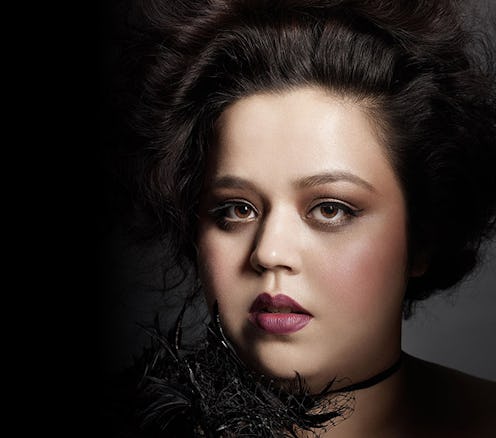Fashion
Where We Need To See More Plus Size Representation

Arguably now more than ever, representation of plus size people in fashion is rising — with everyone from big name brands to independent labels including curve models and even plus size bloggers in many a campaign. With the rise of body positive rhetoric in popular culture, visible shifts in fashion's utilization of plus size bodies are happening. I mean, would Ashley Graham have been on the cover of Cosmopolitan 10 years ago? Probably not, and she's only a size 12/14. Although the bodies we're seeing are unfortunately still primarily white, cis, and smaller fats, doors are being slowly widened.
While fashion may be representing plus size and curvy bodies in ways we've never seen before, however, there's still a noticeable lack of plus size individuals in other media and advertising campaigns. What I'm talking about is the thin-dominated beauty industry. From shampoo ads to makeup campaigns, most of these brands have yet to catch onto the need for plus representation in their imagery. With the exception of MAC Cosmetics' "MACnificent Me" campaign in 2015 and some Ashley Graham images that hinted at a Revlon collaboration earlier this year, few big name makeup companies have made the effort to include folks across the size spectrum.
The New York Times recently posed the question, "Why does the beauty industry ignore curvy models?" And I am at a loss for an answer. After all, there is no legitimate reason for beauty brands to exclude plus size or curve models in their campaigns, considering there's no size limit to hair, makeup, skincare, or anything and everything in between. A fashion label may be able to get away with using only models sizes 10 and under if those are the only sizes being offered there (a questionable decision, in and of itself, of course), but beauty has never been an industry for the thin alone.
The thing is, it's not like there's a lack of plus size beauty bloggers in the world. I've personally never heard a plus size model come forth and adamantly take a stand against being booked for beauty gigs. And it's not like plus size people don't need, want, or use beauty products. As YouTube makeup vlogger Patrick Starrr puts it, "Makeup is a one size fits all."
The reality of not using plus size people — models or otherwise — in beauty campaigns is that it feels like pure discrimination. The assumption that plus size models won't sell product — one seemingly maintained by fashion as a whole for a long time — still feels at the core of the issue. It's an assumption that has been proven to be wrong, however, considering the ever-growing market of plus size brands, as well as brands that promote self-love messaging. I mean, ModCloth's plus size business evolved into a multi-million dollar industry in just a year.
Recently, British plus size model Philomena Kwao spoke out against plus size discrimination in the beauty industry to the New York Times, criticizing the market for seemingly being stuck in its ways. “Beauty brand work [for plus size models] is nonexistent," she told the publication. "I’ve been lucky enough to do a few editorials in the U.K., but I’ve never even been on a casting for mainstream commercial work. When I try to understand it, I think people are scared to try something new. It’s like, ‘I have a formula, why change it?’”
As far as I can tell, the beauty industry is largely falling behind the times in terms of representation. And that's an issue that, all things considered, the industry should have been ahead of. To put it as simply as possible, the beauty industry simply isn't restricted in the way the fashion industry can sometimes claim to be. While clothing brands can argue that their clothes may not fit a plus size figure, a lipstick has never and will never have a size label.
Part of me cannot help but wonder whether now is not the time to be focusing on representation in other industries when fashion is still far from fulfilling its duty on the equal representation front. Even outside of the realm of plus size visibility, there's still a ridiculous lack in representation for people of color, transgender people, and differently-abled people in fashion. Let alone bodies that intersect these minorities. Considering that almost everyone wears clothing, but not everyone wears makeup, perhaps it's more important to tackle fashion first.
When contemplating whether our efforts are best served fighting for plus size representation in one industry versus taking on the whole world at once, I spoke to prominent plus size blogger and fat acceptance advocate Bethany Rutter of Arched Eyebrow.
Rutter tells me via email, "There's no point in fashion operating in isolation from every other industry. It's not like the end goal is 'greater representation of a diverse range of bodies in fashion.' It's allowing a diverse range of bodies to be visible, full stop. This can't just be the realm of fashion, it has to happen across the board, anywhere we have visual representation of bodies."
Her words couldn't better sum up the ridiculousness of the lack of larger bodies in beauty. Ultimately, we need to make the fashion industry reach for more diverse representation. And similarly, we need to hold the beauty industry to the same standards. Inclusion doesn't begin and end with clothing. People come in a myriad of sizes, and the imagery we consume — be it through a magazine ad, a beauty commercial, a television show, or a runway — should all reflect as much.
Image: MAC Cosmetics (1)